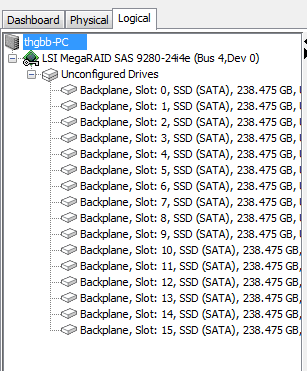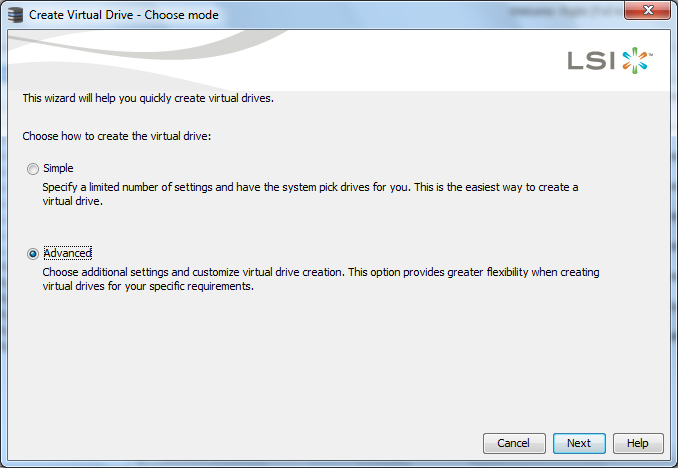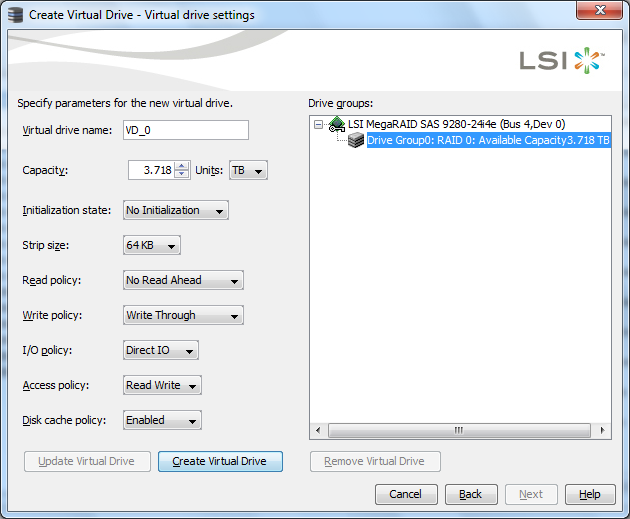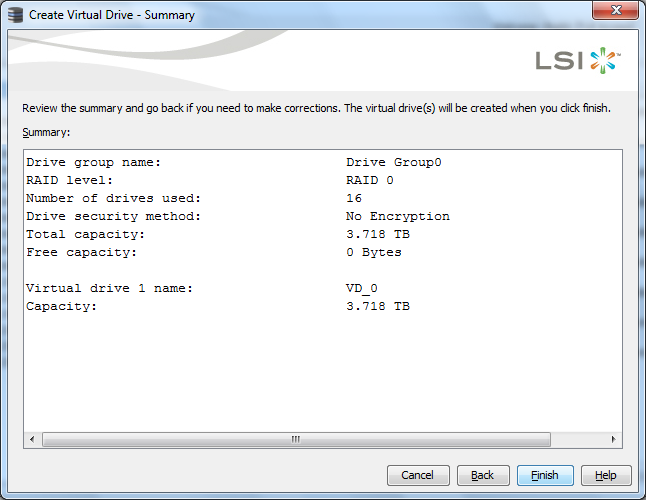A Sexy Storage Spree: The 3 GB/s Project, Revisted
We repeat our extreme SSD RAID project for the third time and arrange 16 Samsung 470-series SSDs based on MLC NAND in a RAID 0 array to reach new levels of performance. We weren't as fortunate this time, but not for the reasons you might suspect.
The Controllers: 1 x LSI MegaRAID 9280-24i4e And 2 x LSI MegaRAID 9260-8i
We used the trusty controllers from our previous test: two PCI Express-based LSI MegaRAID 9260-8i cards, each driving eight SSDs. A new addition was a second type of controller, LSI's MegaRAID 9280-24i4e, which can access all of the drives at once. Let's look at some facts about the 9260-8i first.
The LSI MegaRAID 9260-8i is based on the LSI SAS2108 RoC (RAID-on-chip), which employs a x8 PCI Express 2.0 interface that theoretically allows data rates of up to 4000 MB/s upstream and downstream. The "8i" in the name represents eight internal SATA/SAS ports, each of which provides a peak bandwidth of 6 Gb/s. The controller also has a 512 MB DDR2-800 memory cache, and, depending on the model, a battery backup unit (BBU) that ensures cached data can be written to the NAND flash after a power failure.
The second RAID controller, LSI's Mega RAID 9280-24i4e, offers 24 (instead of eight) internal SATA/SAS connectors, along with four external ones. Aside from the higher port count and larger PCB, the controller is very similar to its smaller colleague, the 9260-8i, because the PCI Express 2.0 interface (x8), RoC, and cache features are identical. Because the 9280-24i4e uses an expander on the controller to make more SATA/SAS ports available, the same bandwidth applies, too.
We used three different test setups to determine the typical performance of the 16 SSDs:
- Eight SSDs on the LSI MegaRAID 9280-24i4e
- 16 SSDs on the LSI MegaRAID 9280-24i4e
- 16 SSDs on 2 x LSI MegaRAID 9260-8i
For all three configurations we created a software RAID in Windows 7. In every case, the configuration of the SSDs went through the controller software from LSI, called MegaRAID Storage Manager.
Creation of a RAID 0 Stripe on the LSI 9280-24i4e
The SSDs can be aligned into arrays using the MegaRAID Storage Manager by following the following steps (LSI MegaRAID 9280-24i4e with 16 SSDs):
Get Tom's Hardware's best news and in-depth reviews, straight to your inbox.
The MegaRAID Storage Manager lists all the controllers connected to SSDs.
Using the context menu command “Create Virtual Drive,” you can create a Virtual Drive designated as a RAID array.
Under RAID Configuration, you can choose between the options “Simple” and “Advanced."
We used the SSDs to form a RAID 0 for the test.
Once all the drives are added to the RAID, further parameters can be defined.
The MegaRAID Storage Manager shows a summary of all the parameters, and creates the RAID array with a click on “Finish."
The Virtual Drive, comprised of 16 SSDs, is now created and has a size of 3.7 TB. Further configuration occurs in Windows’s disk management.
Current page: The Controllers: 1 x LSI MegaRAID 9280-24i4e And 2 x LSI MegaRAID 9260-8i
Prev Page The SSDs: 16 x Samsung 470 (256 GB) Next Page RAID Creation In Windows-
burnley14 Wow, throughput in GB/s. Makes my paltry single SSD look shameful. How fast did Windows boot up out of curiosity?Reply -
the associate Overkill benches like this are awesome, I can't wait to see the crazy shit were gona have in 10 years from now.Reply
burnley14How fast did Windows boot up out of curiosity?
I'd also like to know =D -
abhinav_mall How many organs I will have to sell to get such a setup?Reply
My 3 year old Vista takes 40 painful seconds to boot. -
knowom You can use super cache/super volume on SSD's or even USB thumb drives to dramatically improve the I/O and bandwidth at the expense of using up a bit of your system ram still the results are impressive and works on HD's as well, but they suffer from access times no matter what.Reply
I don't even think I'd bother getting a SSD anymore after using super volume on a USB thumb drive and SSD the results are nearly identical regardless of which is used and thumb drives are portable and cheaper for the density you get for some messed up reason. -
knowom I'd be really interested to see super cache/super volume used on this raid array actually it can probably boost it further or should be able to in theory.Reply -
x3style abhinav_mallHow many organs I will have to sell to get such a setup?My 3 year old Vista takes 40 painful seconds to boot.Wow people still use vista? Was that even an OS? It felt like some beta test thing.Reply -
nitrium I suspect you'll all be VERY disappointed at how long Windows takes to boot (but I'd also like to know). Unfortunately, most operations in Windows (such as loading apps, games, booting, etc) occur at QD 1 (average is about QD 1.04, QD > 4 are rare). As you can see on Page 7, at QD1 it only gets about 19 MB/sec - the SAME speed as basically any decent single SSD manufactured in the last 3 years.Reply -
kkiddu mayankleoboy1holy shit! thats fast. how about giving them as a contest prize?Reply
I WANT 16 OF THOSE !
For God's sake, that's $7000 worth of hardware, not including the PC. DAMN DAMN DAMN !! 3 gigabytes per second. And to think, that while on dial-up 4 years back, I downloaded at 3 kilobytes per second (Actually it was more like 2.5 KB/s).







